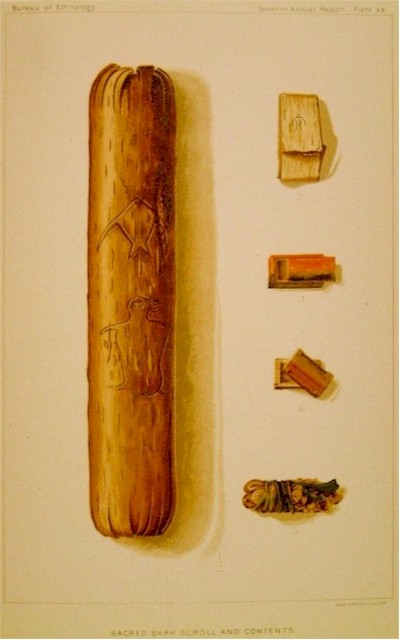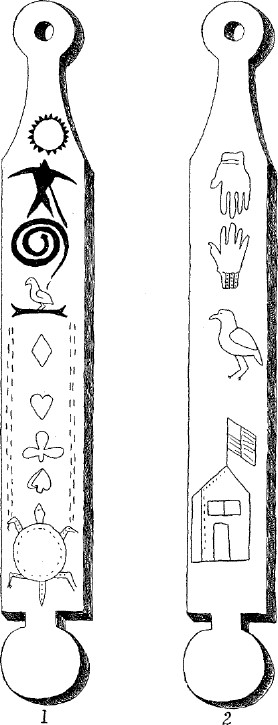|
|
Before concluding, it may be of interest to refer in some detail
to several subjects mentioned in the preceding pages. The mnemonic
songs are in nearly every instance incised upon birch bark by means
of a sharp-pointed piece of bone or a nail. The inner surface of the
bark is generally selected because it is softer than the reverse.
Bark for such purposes is peeled from the trunk during the spring
months. On the right hand upper corner of Pl. XIX is reproduced a
portion of a mnemonic song showing characters as thus drawn. The
specimen was obtained at White Earth, and the entire song is
presented on Pl. XVI, C. A piece of bark obtained at Red Lake, and
known to have been incised more than seventy years ago, is shown on
the right lower corner of Pl. XIX. The drawings are upon the outer
surface and are remarkably deep and distinct. The left hand specimen
is from the last named locality, and of the same period, and
presents pictographs drawn upon the inner surface.
In a majority of songs the characters are drawn so as to be read
from left to right, in some from right to left, and occasionally one
is found to combine both styles, being truly boustrophic. Specimens
have been obtained upon which the characters were drawn around and
near the margin of an oblong piece of bark, thus appearing in the
form of an irregular circle.
The pictographic delineation of ideas is found to exist chiefly
among the shamans, hunters, and travelers of the Ojibwa, and there
does not appear to be a recognized system by which the work of any
one person is fully intelligible to another. A record may be
recognized as pertaining to the Midē´
ceremonies, as a song used when hunting plants, etc.; but it would
be impossible for one totally unfamiliar with the record to state
positively whether the initial character was at the left or the
right hand. The figures are more than simply mnemonic; they are
ideographic, and frequently possess additional interest from the
fact that several ideas are expressed in combination. Col. Garrick
Mallery, U.S. Army, in a paper entitled “Recently Discovered
Algonkian Pictographs,” read before the American Association for the
Advancement of Science, at Cleveland, 1888, expressed this fact in
the following words:
| |
It is desirable to explain the mode of using the Midē´
and other bark records of the Ojibwa and also those of other
Algonkian tribes to be mentioned in this paper. The
comparison made by Dr. E. B. Tylor of the pictorial alphabet
to teach children “A was an archer,” etc., is not strictly
appropriate in this case. The devices are not only mnemonic,
but are also ideographic and descriptive. They are not
merely invented to express or memorize the subject, but are
evolved therefrom. To persons acquainted with secret
societies a good comparison for the charts or rolls would be
what is called the tressel board of the Masonic order, which
is printed and published and publicly exposed without
exhibiting any of the secrets of the order, yet is not only
significant, but useful to the esoteric in assistance to
their memory as to degrees and details of ceremony.
A more general mode of explaining the so-called symbolism is
by a suggestion that the charts of the order or the song of
a myth should be likened to the popular illustrated poems
and songs lately published in Harper’s Magazine for
instance, “Sally in our Alley,” where every stanza has an
appropriate illustration. Now, suppose that the text was
obliterated forever, indeed the art of reading lost, the
illustrations remaining, as also the memory to many persons
of the ballad. The illustrations kept in order would supply
always the order of the stanzas and also the general
subject-matter of each particular stanza and the latter
would be a reminder of the words. This is what the rolls of
birch bark do to the initiated Ojibwa, and what Schoolcraft
pretended in some cases to show, but what for actual
understanding requires that all the vocables of the actual
songs and charges of the initiation should be recorded and
translated. This involves not only profound linguistic
study, but the revelation of all the mysteries. In other
instances the literation in the aboriginal language of the
nonesoteric songs and stories and their translation is
necessary to comprehend the devices by which they are
memorized rather than symbolized. Nevertheless, long usage
has induced some degree of ideography and symbolism. |
|

Plate XX. Sacred Bark Scroll And Contents. |
On Pl. XX are presented illustrations of several articles found
in a Midē´ sack which had been delivered to the Catholic priest at
Red Lake over seventy years ago, when the owner professed
Christianity and forever renounced (at least verbally) his pagan
profession. The information given below was obtained from Midē´
priests at the above locality. They are possessed of like articles,
being members of the same society to which the late owners of the
relics belonged. The first is a birch-bark roll, the ends of which
were slit into short strips, so as to curl in toward the middle to
prevent the escaping of the contents. The upper figure is that of
the Thunder god, with waving lines extending forward from the eyes,
denoting the power of peering into futurity. This character has
suggested to several Midē´ priests that the owner might have been a
Midē´-Jĕs´sakkīd´.
This belief is supported by the actual practice pursued by this
class of priests when marking their personal effects. The lower
figure is that of a buffalo, as is apparent from the presence of the
hump. Curiously enough both eyes are drawn upon one side of the
head, a practice not often followed by Indian artists.
|

Plate XXI. Midē´ Relics From Leech Lake.
|
The upper of the four small figures is a
small package, folded, consisting of the inner sheet of
birch-bark and resembling paper both in consistence and
color. Upon the upper fold is the outline of the Thunder
bird. The next two objects represent small boxes made of
pine wood, painted or stained red and black. They were empty
when received, but were no doubt used to hold sacred
objects. The lowest figure of the four consists of a bundle
of three small bags of cotton wrapped with a strip of blue
cloth. The bags contain, respectively, love powder, hunter’s
medicine—in this instance red ocher and powdered arbor vitæ
leaves—and another powder of a brownish color, with which is
mixed a small quantity of ground medicinal plants.
The roll of birch-bark containing these relics inclosed also
the skin of a small rodent (Spermophilus sp.?) but in a torn
and moth-eaten condition. This was used by the owner for
purposes unknown to those who were consulted upon the
subject. It is frequently, if not generally, impossible to
ascertain the use of most of the fetiches and other sacred
objects contained in Midē´ sacks of unknown ownership, as
each priest adopts his own line of practice, based upon a
variety of reasons, chiefly the nature of his fasting
dreams.
Fancy sometimes leads an individual to prepare medicine
sticks that are of curious shape or bear designs of odd form
copied after something of European origin, as exemplified in
the specimen illustrated on. Pl. XXI, Nos. 1 and 2, showing
both the obverse and reverse. The specimen is made of ash
wood and measures about ten inches in length. On the obverse
side, besides the figures of man´-idōs,
such as the Thunder bird, the serpent, and the tortoise,
there is the outline of the sun, spots copied from playing
cards, etc.; upon the reverse appear two spread hands, a
bird, and a building, from the top of which floats the
American flag. This specimen was found among the effects of
a Midē´ who died at Leech Lake, Minnesota, a few years ago,
together with effigies and other relics already mentioned in
another part of this paper. |
This site includes some historical
materials that may imply negative stereotypes reflecting the culture or language
of a particular period or place. These items are presented as part of the
historical record and should not be interpreted to mean that the WebMasters in
any way endorse the stereotypes implied. The Midē Wiwin or Grand Medicine Society, 1891
The Midē Wiwin or Grand Medicine Society
 |

